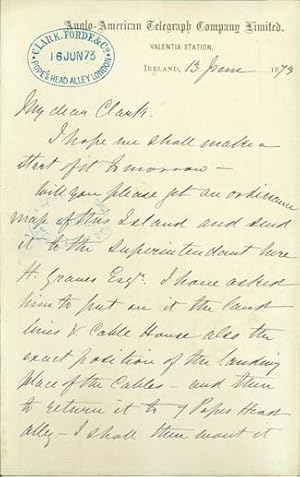Forde, Henry Charles (2 results)
Product Type
- All Product Types
- Books (2)
- Magazines & Periodicals
- Comics
- Sheet Music
- Art, Prints & Posters
- Photographs
- Maps
-
Manuscripts &
Paper Collectibles
Condition
- All Conditions
- New
- Used
Binding
- All Bindings
- Hardcover
- Softcover (1)
Collectible Attributes
- First Edition (1)
- Signed
- Dust Jacket
- Seller-Supplied Images (1)
- Not Printed On Demand
Seller Location
Seller Rating
-
Autograph letter signed to Latimer Clark
Publication Date: 1873
Seller: Jeremy Norman's historyofscience, Novato, CA, U.S.A.
Condition: Very Good. Forde, Henry Charles. A.L.s. to Latimer Clark. Valentia Station, Ireland, June 13, 1873. 1- pp. 205 x 129 mm. Traces of mounting on verso. Provenance: Latimer Clark. Forde, an electrical engineer, worked on the installation of the first (unsuccessful) Suez-to-India cable in 1859, and with Clark and Bright on extensions of submarine lines in the Indian telegraph system in the 1860s. In 1868 he and Clark established the cable-laying firm of Clark, Forde, and Taylor, based in Pope's Head Alley, London. In his letter he asks Clark to "get an ordinance map of this Island [Ireland] and send it to the superintendant [sic] here. . . . I have asked him to put on it the land lines and cable house also the exact position of the landing place of the cables. . . ." Origins of Cyberspace 143. .
-
London, William CLowes and Sons, 1863. 8vo. In the original printed wrappers with Siemens's inscription to front wrapper: "to Mr. A. L. Ternant / from Author". With previous owner's stamp to lower part of front wrapper: "A. L. Ternant". Lacking upper part of spine, a few marginal annotations in pencil throughout. 50, (5) pp. + 3 large folded plates. First printing of this important publication in the history of telegraphs cables with a most interesting presentation inscription: It was given by Siemens to A. L. Ternant, author to several early paper on submarine cables. The Malta-Alexandria cable was ordered by the British government, manufactured by John Pender, and constitute one of the very first submarine telegraph cables. "The making and laying of the Malta to Alexandria cable gave rise to researches on the resistance and electrification of insulating materials under pressure, which formed the subject of a paper read before the British association in 1863. The effect of pressure up to 300 atmospheres was observed, and the fact elicited that the inductive capacity of gutta-percha is not affected by increased pressure, whereas that of india-rubber is diminished. The electrical tests employed during the construction of the Malta and Alexandria cable, and the insulation and protection of submarine cables, also formed the subject of a paper [the present]." (Munro, Heros of the Telegraph, P. 72). The Malta-Alexandria cable was the first Siemens was involved in and the experience made him in 1874: "design the cable ship Faraday and assisted in the laying of the first of several transatlantic cables that it completed. During the last fifteen years of his life he actively supported the development of the engineering profession and its societies and stimulated public interest in the conservation of fuel, the reduction of air pollution and the potential value of electric power in a wide variety of engineering applications.(DSB).In 1859 Glass, Elliot and Company received an order from the British Government to manufacture and lay a cable from Falmouth, England to Gibraltar. The government then changed the route to Rangoon - Singapore and finally to Malta - Alexandria, Egypt.



